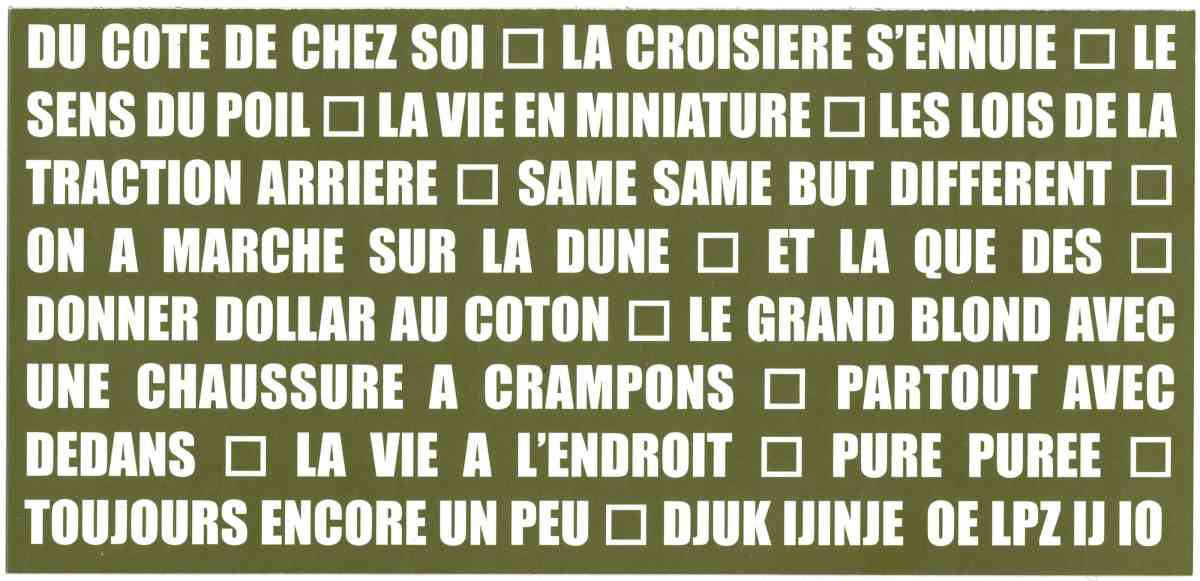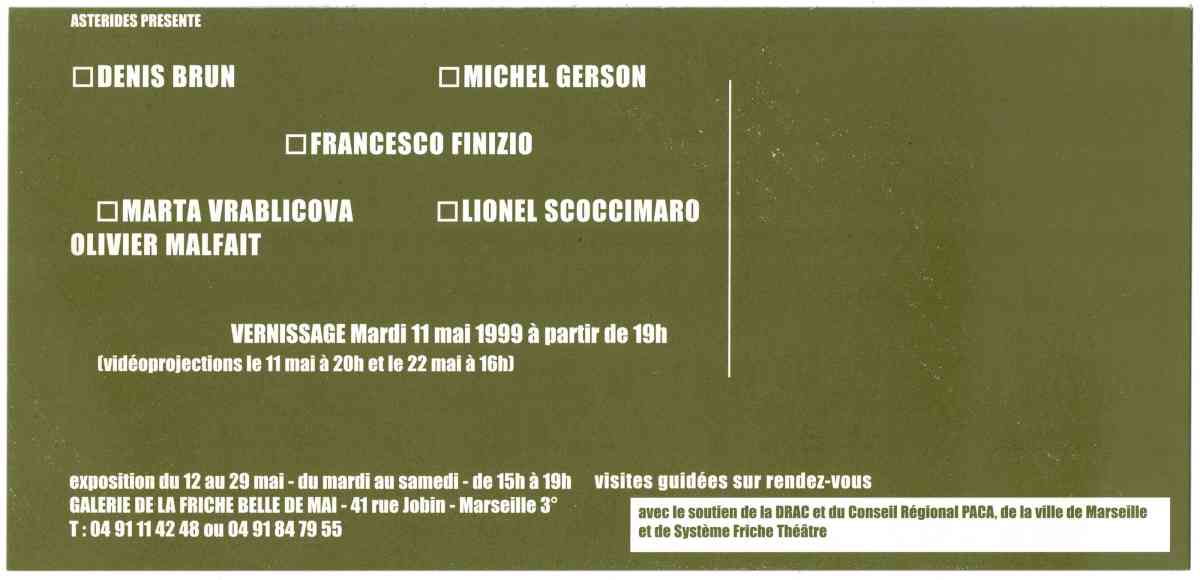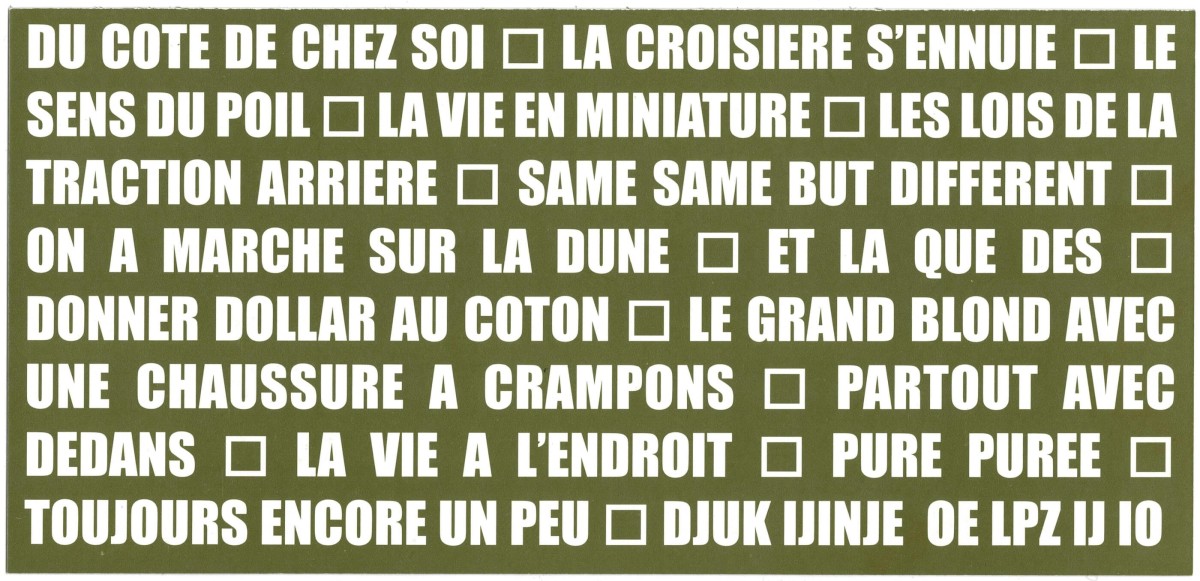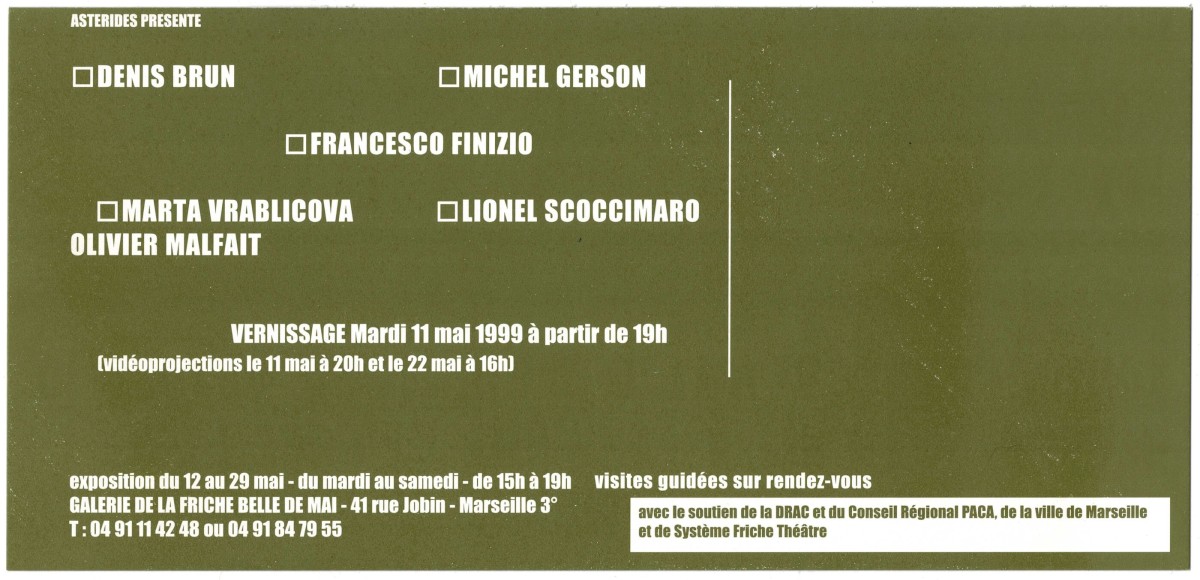Denis Brun, Francesco Finizio, Michel Gerson, Marta Vrablicova, Olivier Malfait, Lionel Scoccimaro
Collective show with Denis Brun, Francesco Finizio, Michel Gerson, Marta Vrablicova, Olivier Malfait and Lionel Scoccimaro
May 12 - 29, 1999
Galerie de la Friche la Belle de Mai, Marseille
For three weeks at La Friche Gallery, Astérides presents an exhibition bringing together six artists.
Unlike Michel Gerson, who completed a short one-month residency in the association’s studios, Denis Brun, Marta Vrablicova, Olivier Malfait, and Lionel Scoccimaro are among the new residents welcomed in April 1999 for a six-month stay.
For this exhibition, the five residents have chosen to invite Francesco Finizio.
The exhibition is not to be seen as a stage marking the end of a residency period.
Through a selection of recent and less recent works brought together in the same space, it reflects various creative processes, offering a space for dialogue between the works.
Michel Gerson is from Nantes. His decision to work in Marseille for a short time is part of an ongoing approach centered around notions of traces and circumstances that, once gathered and placed in resonance, tell stories—stories of the artist’s encounter with a specific place. Here, that place is Marseille.
Through his interactions with its people (close acquaintances or neighbors), its places (whether transient or long-term), its beliefs, customs, and cuisine, Michel Gerson captures singularities, impressions, moments, and expressions. After a long period of immersion, he takes photographs, videos, and sketches that serve as notes. He then creates connections between these subjects, mapping them onto supports chosen for their relevance to the place of work.
For this exhibition, he will present a series of bedsheets from Marseille hotels (“May the Sheets Remember”), enhanced with sketches made using locally sourced materials (henna, wine, spices, eosin…), recounting his initial contact with the city. These latent stories take form in a way that is both instinctive and sensitive, created within a very short time, revealing a daily entanglement of the artist’s work and private life—and vice versa.
The direct environment and everyday events are also a source of inspiration for the Lille-based artists Marta Vrablicova and Olivier Malfait.
They explore reality and its fictional potential, working within a space that borders both portraiture and documentary. They film life around them (neighborhood scenes, interior settings…) over long periods, collecting images and fragments that are later structured into a narrative.
Sometimes, the story emerges through editing, with the narrative potential of one image leading to the next (“Le parking”); the meaning of the film becomes inherent to the images used and their juxtaposition. At other times, the script precedes the film (“Only You”), written and constructed so that the viewer is drawn into the unfolding of the story.
Marta Vrablicova and Olivier Malfait reveal layers of meaning that serve as starting points for open interpretations. These layers chart the distance between the notions of the “individual” and the “collective.”
Denis Brun, an artist from Nice, works with self-portraiture, which he reinterprets through a dreamlike tradition. The self-portrait is the “raw material” underlying his work.
Whether in the form of short films, drawings, photographs, or garments, each work is imbued with personal references, as they are materializations of the artist’s imaginary world.
Denis Brun refers to them as “dreamlike fictions.” This term applies equally to his videos, “soft paintings,” or installations, as each piece carries a narrative potential. These narratives are built using preexisting, meaningful images drawn from diverse sources (home video clips, television, magazines, salvaged papers…).
He enjoys working with objects that are not his own—because they were created by others—in order to transform them, arranging them in such a way that their meaning, also shaped by the viewer’s perception, draws closer to a collective consciousness.
Denis Brun’s world emerges from the immediacy of his perception, in an instinctive and joyful way. As if, with each new idea, a magic wand created a new inhabitant of a world whose fantasy is meant to be shared by all.
The notion of pleasure appears as one of the driving forces in Lionel Scoccimaro’s practice.
He multiplies pretexts. These are the starting points of his pieces: pretexts to “make,” to engage with one tool over another (photography, computer), with a theme (challenging political correctness), or with a mode of representation (pornography, sensational news).
His work tends toward cynicism and provocation. Yet, when placed in relation to one another, the pieces form a coherent universe that reveals a clear and deeply rooted artistic stance.
Lionel Scoccimaro confronts his social, political, and cultural environment directly, without concessions to imposed decorum. Through accessible references such as childhood or play, these seemingly playful and seductive assemblages quickly draw the viewer into the artist’s serious, thoughtful ideas.
His installations, photographs, and brightly colored casts are part of a complex process. Starting from a hedonistic attitude, passing through confrontation with a practice, and resulting in objects of assertion, they open multiple questions about society and its rules: to what extent can established norms be transgressed? Such is the question posed by the piece “Sweet Dream”…
Francesco Finizio’s work, developed in Marseille where he lives and works, occupies an in-between space: between public and private life, between reality and imagination.
His installations could be seen as attempts to reconcile existing dichotomies. Yet their inability to fully integrate the real keeps them in a state of schizophrenia.
This confusion, created by the artist, allows him to escape material contingencies in order to think through them more freely. Through a poetic field marked by critical potential, he works to create openings.
By playing with modes of thought that revisit reality (metaphors, transfers, aphorisms), rather than simply diverting it, Francesco Finizio “provokes a constant slippage between an observed reality and a touched imaginary, between a suggested imaginary and an intensified reality. His proposals and objects pierce, cut through an eventful, emotional fabric of words and meaning, images and desires, paradoxes and ambiguities, but ultimately remain within the simple admission of breaks, doubts, and voids, which makes them permeable to a poetry of failure, of its undefinable elation.”
Text by Didier Arnaudet



